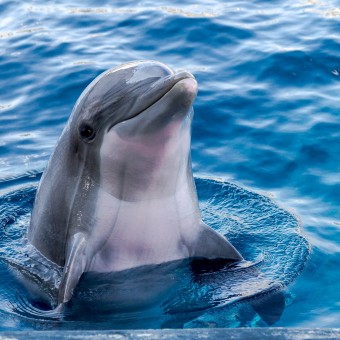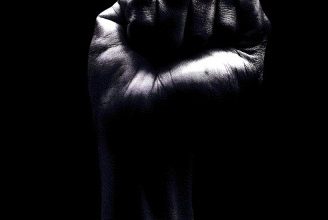
The Dolphins by Carol Ann Duffy is dramatic monologue voiced by a dolphin which revolves around the themes of exploitation displacement, alienation and the need for ecological conservation. The poem presents us a disturbing picture of what unregulated power is capable of doing to the lives of others. It provides us a perspective of the oppressed and thoroughly incriminates man for his love of power and dominance over others.
The speaker of this poem (a dolphin) narrates how its freedom has been usurped, how its dreams have been shattered and how drastically its world has changed, thanks to the insatiable greed of man. The lives of these beautiful sea creatures are completely controlled by man and they are made to dance to the tunes of the Master. The sense of alienation, their loss of freedom and the overarching hopelessness makes the poem all the more poignant, especially when they express their awareness of the inevitable fate that awaits them.
The Dolphins | Summary And Analysis
The Dolphins | Stanza 1
World is what you swim in , or dance, it is simple.
We are in our element but we are not free.
Outside this world you cannot breathe for long.
The other has my shape. The other’s movement
forms my thoughts.
And also mine.
There is a man and there are hoops.
There is a constant flowing guilt.
The poem opens on a disturbing note where the dolphins narrate what their world has been reduced into. The poem largely employs the use of first person point of view and carries a dejected and a wry tone. The act of swimming and dancing both refer to a form of movement. However, there’s a world of difference between the two insofar as the situation of the dolphin is concerned. Swimming connotes a sense of freedom and volition whereby the dolphins could choose to navigate the expansive ocean. Dancing, on the other hand underscores a sense of confinement where a dolphin is forced to ‘dance’ in front of the spectators. Its identity as a sea-roving creature has been has been overlooked and its life has become a public spectacle. Dolphins are made for swimming and an unwilling, dancing dolphin is rarely a happy one. By forcing the dolphin to perform some people-pleasing tricks, man makes it go against its nature and denies the identity it actually has, thereby reducing it to a plaything. The phrase ‘it is simple‘ in the first line of the poem betrays a hopeless resignation the dolphin has come to embrace.
It is important to note that even their swimming isn’t a voluntary one: the dolphins’ natural movements are controlled by man whether it be through the limits of the pool or the instructions he gives through his whistle.
The dolphins are made to play any role that pleases the master, whether it is dancing, swimming or balancing balls. Their identity is made to occupy various molds, quite like water, the “element” they live in which takes the shape of any container it is stored in.
The first stanza makes it clear that the dolphins have no option. Though it is placed in water (we are in our element), it is not free, for the moment it tries to escape, and death will become inevitable as it will not be able to “breathe for long”. The pool is a stagnant space where the native becomes a captive and motion becomes stasis. The freedom the dolphins long for lies beyond the aquarium but any attempt to get out of it will result in immediate death. The denial of their freedom by the shrinking of the “world” they inhabit merely allows them to exist without letting them actually live. In other words, the dolphin makes it clear that one can go on existing without actually living and that freedom is a prerequisite to a full-blown life. This is exactly what has been denied. The dolphins are caught between the devil and the deep sea. Only in this case, the Devil is Man himself and the deep sea is but a shallow aquarium.
One of the distinctive features of this poem is its ambiguity. The poem throws up interesting questions precisely at points where one is most confident about its meanings. A case in point is the use of the word ‘other‘ in the first stanza:
The other’s movement
forms my thoughts.
And also mine.
What does the word actually stand for? Does it refer to the ocean which commands its physical and emotional yearning (forms my thoughts)? Or is it the ‘other’ dolphin, its companion, whose movements in the aquarium shapes its thoughts while mirroring its tricks? Or is it its own reflection on the aquarium walls which he seems to take for another dolphin? Or is it all of these?
Also, what does the line “And also mine.” signify? More importantly whose ‘mine‘ is this? Is it the dolphin who is wistfully repeats his own sentence? Or is it (as seems probable) an utterance of another dolphin who is seconding the voice of his inmate by echoing his thoughts? If this is the case, we then begin to see that there is no single speaker involved. The poem attacks our assumption of such a poem being a monologue spoken by an individual. In such a case, the poem doesn’t remain a monologue of a dolphin but rather collective voices of dolphins who are expressing their collective misery. Again, the use of we gains a heightened meaning as it doesn’t merely stand for the collective but is voiced by the collective. The title of the poem The Dolphins then gains a greater relevance in the same way.
The water that contains and controls the dolphins isn’t devoid of man and his tools of oppression whether it be in the form of hoops or plastic balls. It is clear that the aquarium is flooded with waters of guilt. But then again, whose guilt is it? Is the dolphin’s self guilt for having fallen to the nets of man? Or does it represent man’s unacknowledged ‘guilt’?
The Dolphins | Stanza 2
” We have found no truth in these waters,
no explanations tremble on our flesh.
We were blessed and now we are not blessed.
After traveling such space for days we began
to translate . It was the same space. It is
the same space always and above it is man.
The waters where the dolphins are kept isn’t their friend and certainly not a medium of justice where Truth may be sought: We have found no truth in these waters. Rather, it is complicit in the ruthless exploitation of the dolphins by functioning as a tool of oppression – one with which the dolphins may be kept alive just so that they may be exploited. It is with the aid of water that the existence of dolphins becomes a means to someone else’s ends. The dolphins were blessed when they freely traversed the vast expanse of the ocean. Unfortunately, they are not blessed anymore. Their erstwhile blessed life has become a cursed existence and Man is the cause of this reversal.
The dolphins took days to register the grave, undeserved injury inflicted on them. However, after days of the traumatic experience they have begun to realize (translate) that there’s not much difference between the large ocean or a small pool . ‘It is the same space ‘ as both spaces are not free from the domination of man.
The Dolphins | Stanza 3
And now we are no longer blessed, for the world
will not deepen to dream in. The other knows
and out of love reflects me for myself.
We see our silver skin flash by like memory
of somewhere else. There is a coloured ball
we have to balance till the man has disappeared.
The third stanza takes the reader to poignant heights through the loss of depth which is the ocean. A sad reality of the dolphins is that their “world will not deepen to dream in “: they have nothing beyond their present condition. Their self-realization and self-fulfillment stops with the bottom of the pool. Their life has become a forgotten memory and their identity a reflection on the aquarium glass where they see the reflection “flash by like memory of somewhere else”.
The ‘coloured ball ‘which they have to balance and the plastic toy” referred in the third stanza lends a form of artificiality their life has been reduced to.
The Dolphins | Stanza 4
The moon has disappeared. We circle well-worn grooves
of water on a single note. Music of loss forever
from the other’s heart which turns my own to stone.
There is a plastic toy. There is no hope. We sink
to the limits of this pool until the whistle blows.
There is a man and our mind knows we will die here.
This stanza is replete with a sense of confinement and claustrophobia. We realize that the dolphins’ loss includes not only the expansive ocean but also a limitless sky. The moon has disappeared for them and the colored ball they balance functions as a sickly substitute to the splendid sphere of the night sky. They circle “well worn grooves of water on a single note “. Notice the sense of monotony conveyed by the use of “a single note” that not only refers to the monotony of movement but also a monotony of sound which is extended in the next line:
“Music of loss forever from the other’s heart which turns my own to stone”
One remarkable quality the dolphin embodies (and which is clearly lacking in Man) is empathy. Like most social animals, dolphins have a developed sense of communication. Coupled with the fact that they use high frequency sounds (echolocation) to communicate in the form of clicks, it is quite natural how the music of loss for one dolphin should be instantly detected by another. Also, the use of internal rhyme (my own to stone) and the brilliant imagery of death and heaviness conjured by the use of the word “stone” is fully realized when the dolphin, like the stone, ‘sink‘ in the next line, thereby, completing the imagery in a wholesome unity.
The ‘plastic toy‘ in this stanza not only highlights the artificial external addition to the dolphin’s life but also refers to the dolphins themselves for they have become toys as well. The dolphins sink to the limits of the pool but their freedom to do so isn’t just restricted by the bottom of the pool, for they are free to do only until the whistle blows “.
The last line of the poem betrays a sign of fatalism and hopelessness which weighs down these magnificent creatures:
There is a man and our mind knows we will die here.
The fact that they are fully aware of their inevitable death, that they are dancing to the tunes of man despite this knowledge and moreover that there’s nothing they can do about it imbues this poem with a dark reality which throws up an uncomfortable truth before us and presents before us a reality which we have had a hand in making. Thus, by giving a voice to the voiceless creatures and pointing at the crimes man has committed against other life forms, the poem also emerges as a fine example of ecocritical writing.
As mentioned earlier, the entire monologue uses a plural instead of a singular, always ‘we’ instead of an ‘I’ which suggests that this is not an isolated case. Rather, the mode of oppression exercised by man extends over a large number of creatures. This sense of solidarity of the oppressed highlighted by the collective noun ‘we’ lends a great magnitude to the voice of the oppressed. The poem can also be seen as a commentary on the power relation between man and vast swathes of society that have faced the full force of oppression based on their gender, race, caste, creed or nationality. The poem bears a strong feminist undertones by the virtue of which ‘we’ could be used to designate women who have been marginalized in the socio-economic power structures deeply embedded in our society. The repeated use of ‘man‘ as the oppressor to the collective “us” lends some weight to this reading.
Thus, one could argue that by using the trope of animals Duffy is also highlighting the forms of oppression within human society where various sections of the society are denied agency and whose lives have been reduced to mere existence.
The Dolphins : About the poet
Born to working class Roman Catholic parents in Glasgow, Carol Ann Duffy is the first female poet, first Scot and first openly LGBT person to be named the Poet Laureate of England. Carol began writing poems from the age of 11 and had published several of her works by the time she turned 16. Two English teachers June Scriven and Jim Walker were instrumental in discovering her talents and encouraging her to publish poems in various magazines. Duffy graduated from the University and lectured at Manchester Metropolitan University .
Her first collection of poems Female Standing Nude deals with the construction of femininity through art and culture and questions the same. The collection won the Scottish Arts Council Prize. The World’s Wife represents the retelling of myths and history voiced by the wives and lovers of famous men ranging from Sisyphus to Aesop. Mean Time won the Whitbread poetry award and Rapture bagged the T.S Eliot Prize. Duffy was also named fellow of the Royal Society of Literature.
Her poems show the ability to voice out the concerns of a diverse variety of subjects with utmost depth and sincerity. Themes of oppression, violence, ecological conservation and sexuality find recurrence in most of works. Her dramatic monologues prove to be very effective in voicing the concerns of the marginalized as is seen in the poem The Dolphins.




Far better explanation than most of the textbooks out there !!
Thanks
Such a well written explanation of the poem. Thanks 😊
This is a remarkable analysis of Duffy’s poem. Very insightful.
this explanation is sooo much helpful …before this i had never came across such explanation…..
December 28th , 4:50am.
I love how you compared the poem with human race. I even love how you expressed the finest details.
thank you soo much.
I have my exam in 4 hours and this helped me a lot.
We’re glad this was useful.
Beautiful analysis of the poem.
Such a beautiful explanation of the poem I ???? this explanation it is very helpful for me
The appreciation from students is what keeps us going 🙂
This is the best explanation I hav ever came across. By reading and understanding the poem in a crystal clear way , it has open a new world for me of how poems too can be very understandable and meaningful. Thanks a lot.
Kudos to you team…! ????????????????
BEST SUMMARY OF THE DOLPHINS I HAVE EVER READ SO FAR. Thank you for sacrificing your time for us.I promise this sacrifice won’t go to waste. What a person you are!
You’re welcome. It’s the enthusiasm of readers like you that keep us going 🙂